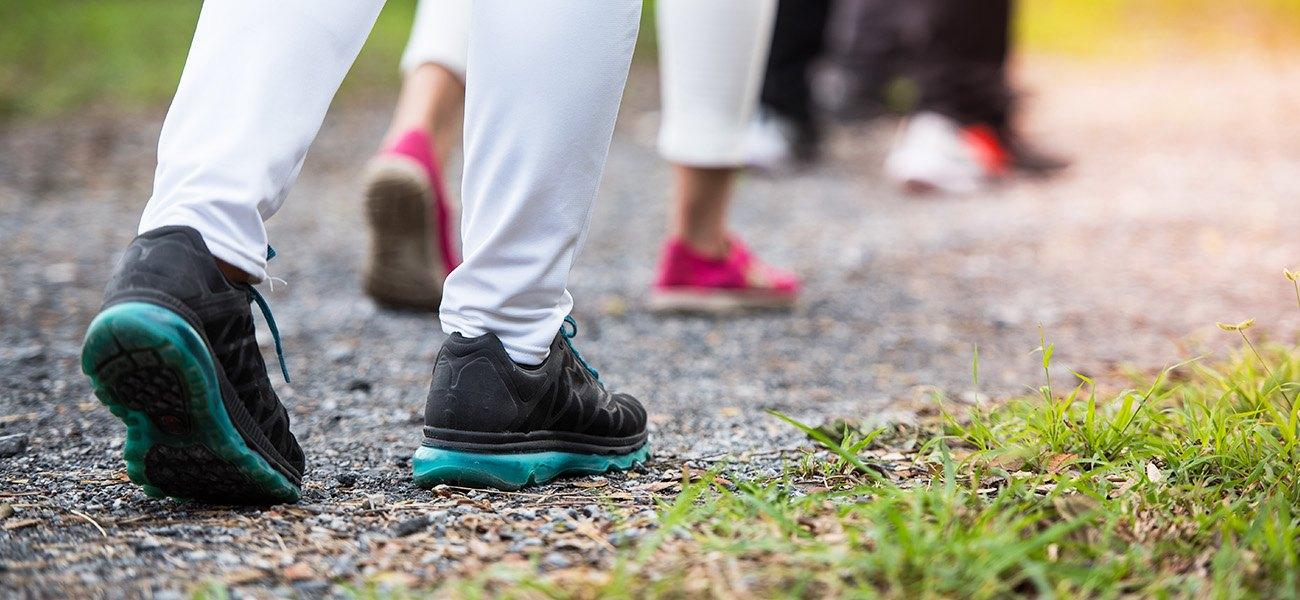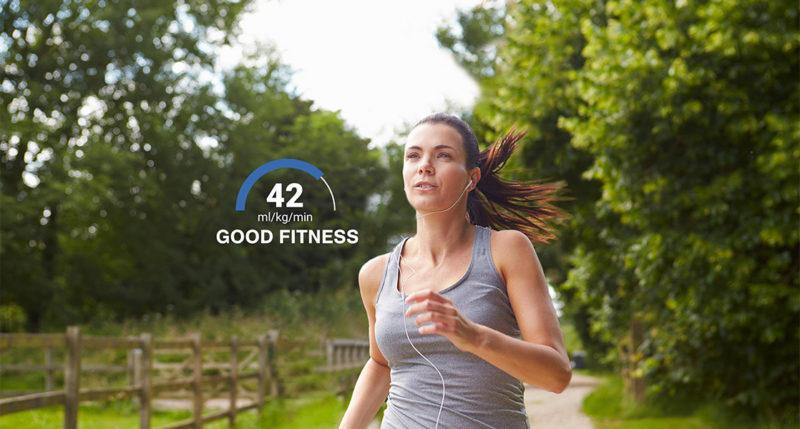
Fitness translates to quality of life – Do you want to find out what your Fitness Level is?
Fitness Level is a feature in Firstbeat Lifestyle Assessment that provides an accurate estimate of your fitness based on 30 minutes of moderate-pace walking.
Getting an estimate of your fitness level motivates people of all fitness levels to remain, or become, physically active and pay attention to their daily physical activity. Good fitness is an essential component of comprehensive well-being: studies show that people who are fit experience less stress and recover better during sleep than people who are unfit.
The Fitness Level is an easy and concrete way to follow up your fitness development as part of Firstbeat Lifestyle Assessment measurements.

(Example) VO2max reference values used with permission from the Cooper Institute, Dallas, Texas
Lifestyle Assessment Fitness Level –How Does it Work?
Lifestyle Assessment estimates the maximal oxygen uptake by comparing the body’s workload to walking speed. Firstbeat’s algorithm monitors the relationship between the person’s walking speed and heart rate and automatically detects appropriate segments to be used in fitness level estimation.
Fitness Level can be estimated if at least one 30-minute period of brisk walking is detected in the measurement. The most accurate results are gained if the walking is done on flat terrain. The result is compared to people of the same age and sex.
Fitness Level estimation offers significant benefits both to the participant and to the wellness professional. The participant gets an accurate estimate of his/her aerobic fitness level and information about whether the fitness is sufficient to promote and support good health. In addition, the Fitness Level feature can function as an effective motivator to become physically active and improve personal fitness.
Note! Estimating the maximal oxygen uptake level from brisk walking is only appropriate for people who are used to being physically active and who do not have an illness or condition that limits their ability to walk or exercise, or medication that has a strong effect on their heart rate, such as beta blockers.
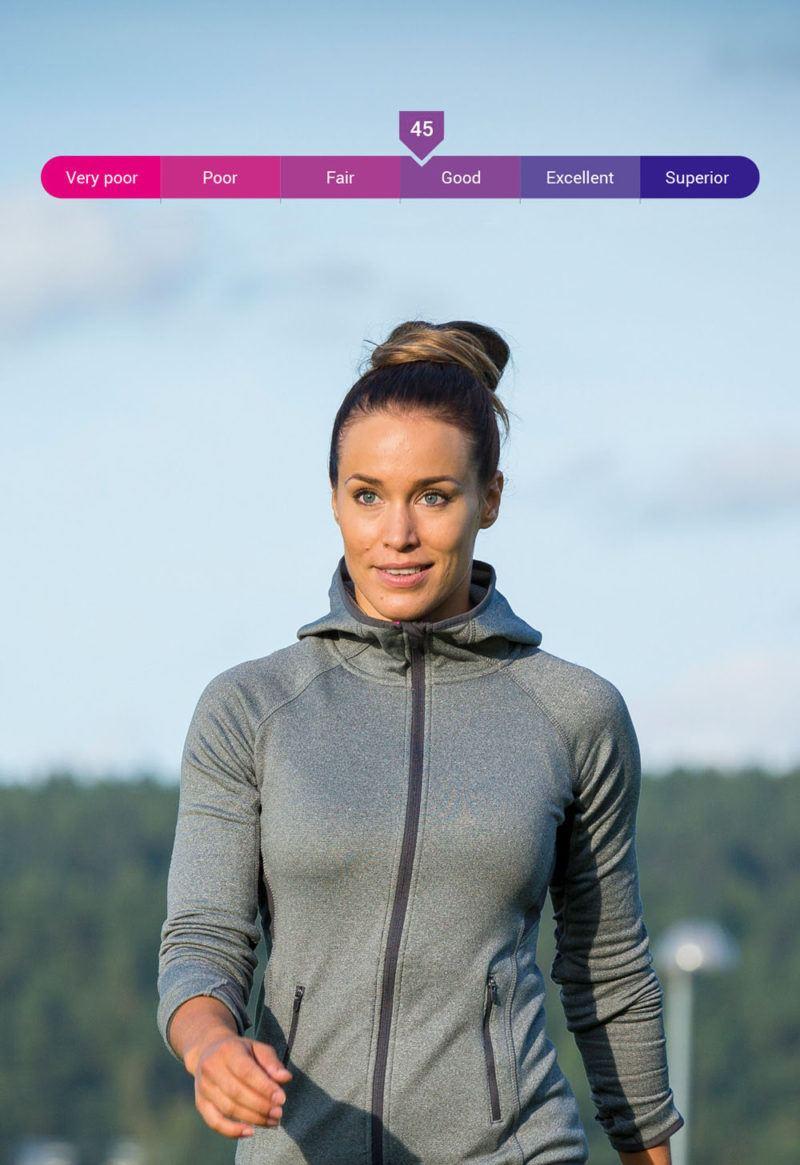
Maximal oxygen uptake – A measure of aerobic fitness
Maximal oxygen uptake (VO2max) describes
the ability of the cardiorespiratory system to deliver oxygen to working muscles and the ability of the body to utilize oxygen to produce energy during exercise. High maximal oxygen uptake means good endurance, which research has shown to be associated with better health and performance and reduced mortality risk.
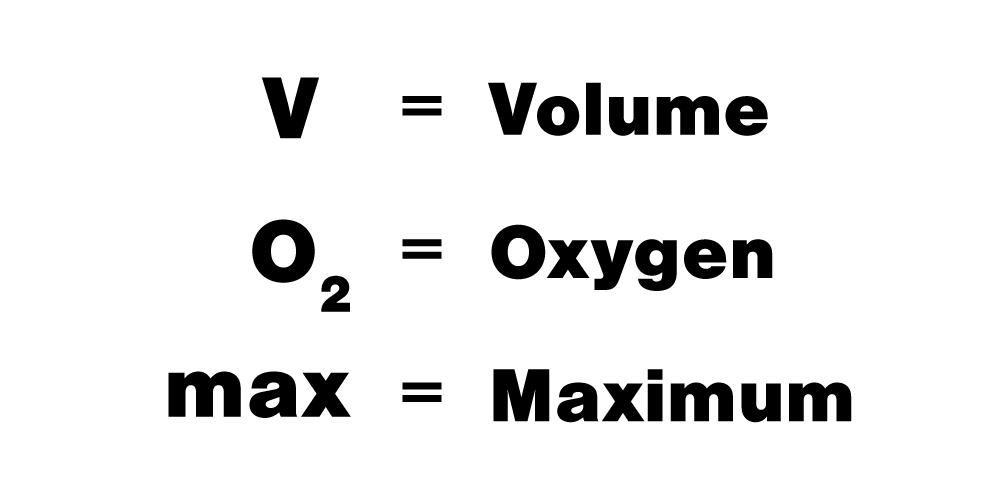
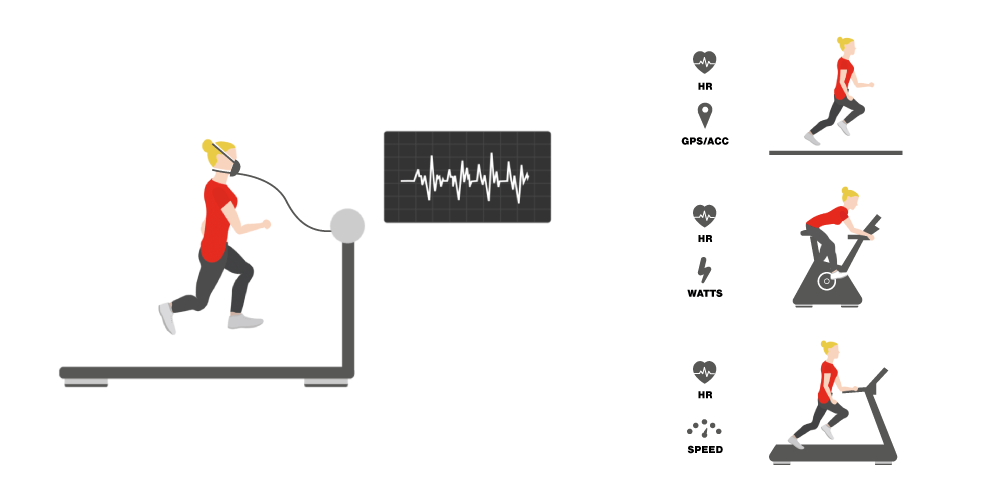
Maximal oxygen uptake is measured
in the laboratory by analyzing respiratory gases, and its unit is milliliters of oxygen per minute per kilogram of body weight (ml/kg/min). Maximal oxygen uptake is usually in the range of 20-70 ml/kg/min. Traditionally, measurement of a person’s fitness level has required laboratory conditions, but now it’s possible to get an estimate of your fitness level as part of the 3-day Lifestyle Assessment.
Why is Fitness Level important?
5 reasons to boost your Fitness Level:
- Feel better and less stressed
- Breeze through daily challenges
- Faster, higher, stronger
- Top up your health
- Turn back the clock
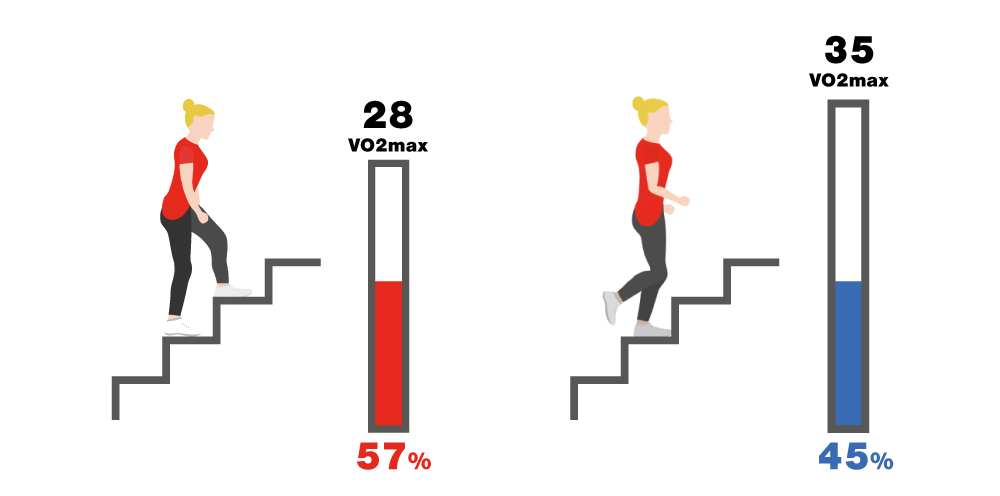
Climbing stairs has a typical VO2 cost of 16ml/kg/min. To walk up stairs, someone with a poor fitness level, VO2max 28, is performing at 57% of their total aerobic capacity. Meanwhile, with a VO2max of 35, those same stairs are conquered while working at only 45% capacity.

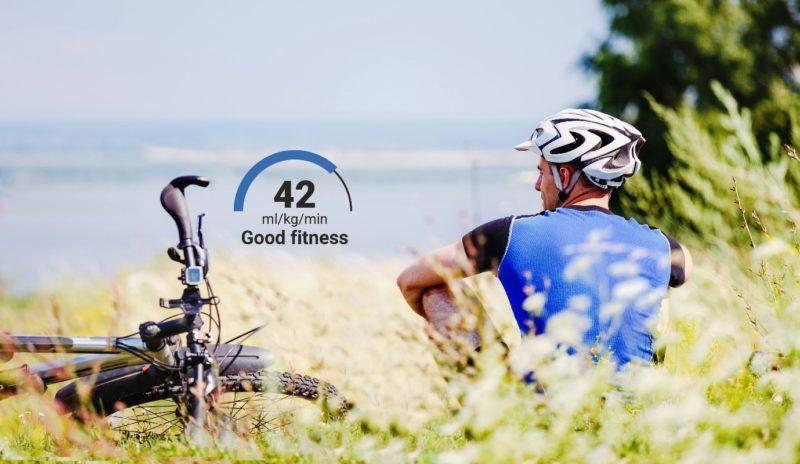
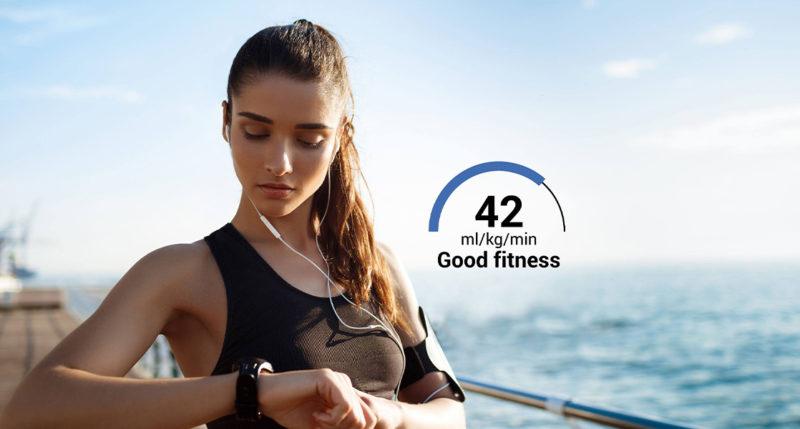
Frequently Asked Questions (FAQ)
Performing the walk
How do I initiate the Fitness Level measurement during the Lifestyle Assessment?
Fitness Level is always estimated if a 30-minute period of brisk walking is detected in the measurement. There is no need to separately start or initiate the Fitness Level measurement. Do not conduct the walk right after other exercise or other strenuous activity.
Can I do more than one walk during my Lifestyle Assessment? Can these other walks be something other than walking on level ground (e.g. walking my dog, walking in the forest or in hilly terrain, hiking with a backpack or carrying shopping bags)?
You can go on about your normal life during the Lifestyle Assessment, and the measurement can include more than 1 walk. Estimating the Fitness Level requires that the measurement includes at least one continuous, moderate to brisk 30-min walk. The most accurate result is reached if you are not walking a dog or carrying walking poles or other extra loads. If we identify more than one applicable walking period in the measurement, we will utilize the information gained from all the periods to make the most accurate estimation of your Fitness Level.
Do I get a better result if I walk faster?
The Fitness Level is determined by the relationship between workload (heart rate response) and walking speed, and you can freely select your walking speed. The result is not necessarily better if you walk faster. The most accurate result is reached if you walk at a pace that is brisk for you.
I’m a runner – can I get a Fitness Level estimation from running?
Fitness Level can only be estimated from walking. Running or other sports will not allow us to calculate the Fitness Level. Fitness Level can also not be calculated if you walk after other exertion, for example right after a run or other strenuous exercise.
Can the Fitness Level be estimated if the walk is done in the gym on a treadmill?
Yes! A treadmill is a good place to perform the 30-min walk.
Can I stop during the 30-min walk, for example for traffic lights?
Yes, you can. However, estimating the Fitness Level requires 30 minutes of fairly continuous walking. A few short pauses are ok and do not affect the estimation.
What is the minimum distance that I need to cover to get a Fitness Level estimate?
Fitness Level estimation requires that your walking speed is on average at least 4 km/h. At this pace, you will cover over 2 km during the 30 minutes.
Does it matter if I walk longer than 30 minutes?
No! You can walk as long as you wish.
Reliability of Fitness Level
How reliable is the Fitness Level that Lifestyle Assessment provides?
A laboratory measurement, where oxygen and carbon dioxide are measured from respiratory gases during the test, is the most accurate method (gold standard) of fitness testing. Lifestyle Assessment offers a very easy and effortless way of estimating your fitness level, in other words, it’s a low-threshold fitness test. In our own research, the mean error to laboratory results has been 6–9 %. This means that the average difference to laboratory results is app. +- 3 ml/kg/min. In short: Fitness Level estimation in Lifestyle Assessment provides an accurate estimate of your fitness level for practical purposes, with minimal effort.
Why does hilly terrain affect the reliability of the Fitness Level estimation?
The most accurate estimation is reached if you walk on fairly flat terrain because the Fitness Level is estimated from the relationship between workload and walking speed. Hilly terrain influences both load (via elevated heart rate) and walking speed, and this makes the estimation less accurate.
Are the reference values reliable?
VO2max reference values are used with permission from the Cooper Institute, Dallas, Texas
Scientific background
What is the Fitness Level classification based on?
Fitness Level is determined in relation to other people of the same age and sex because it’s known that aerobic fitness decreases with age, and men typically have somewhat higher maximal oxygen uptake than women. Fitness Level categories have been developed based on scientific studies, in which the fitness levels of different age groups have been measured in a laboratory. Your Fitness Level reveals what your own aerobic fitness is in relation to your age and sex cohort.
What is the best possible VO2max value?
Typically, maximal oxygen uptake ranges between 20–70 ml/kg/min.
How do I compare the Lifestyle Assessment Fitness Level to other commonly used fitness tests (muscular fitness test, laboratory tests, Cooper test)?
Lifestyle Assessment Fitness Level estimates the level of your aerobic (endurance) fitness; thus, it does not evaluate your muscular fitness or strength. Direct maximal oxygen uptake tests conducted in a laboratory are popular especially with athletes and they require maximal effort. The Cooper test also requires 12 mins of maximal effort and is not suitable or recommended for evaluating the fitness of large groups of people with a range of different health conditions. Lifestyle Assessment determines the fitness level based on self-paced walking and it does not require maximal speed or exercising until exhaustion. It is a reliable fitness level evaluation method for practical purposes and applicable for large groups of people.
